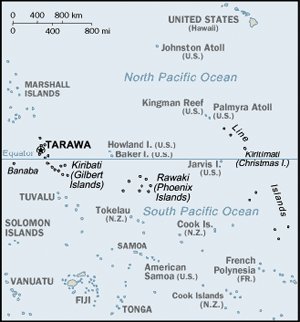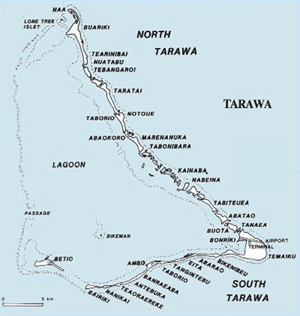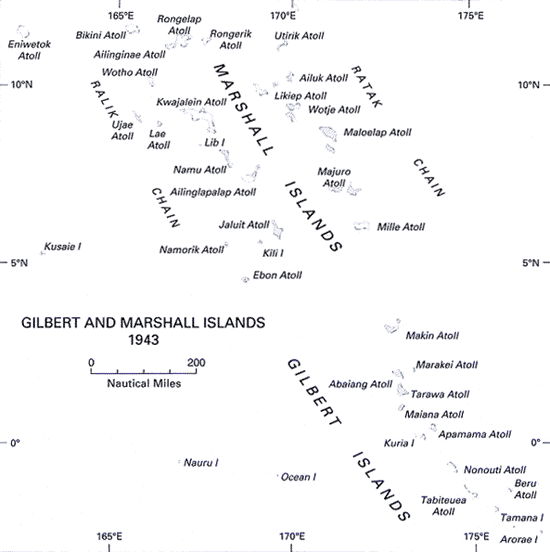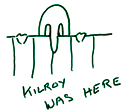The Stamford Historical Society Presents
Pride and Patriotism: Stamford’s Role in World War II
Online Edition
The Battles
The Battle of Tarawa
 The Battle of Tarawa was fought on Tarawa Atoll from 20 November to 23 November 1943. It was the second offensive of the U.S. in the Pacific, the first being the Guadalcanal Campaign. It was the first battle of the Central Pacific campaign of island hopping to the Japanese mainland. It was also the first time U.S. amphibious landing that faced serious Japanese resistance. The United States forces totaled some 35,000 troops under Rear Admiral Howard F. Kingman and General Holland Smith. The Japanese commander, Rear Admiral Shibasaki Keiji, had 2600 troops, 1000 Japanese workers and 1200 Korean laborers. The reason for taking Tarawa was primarily to set up airbases where bombers could be stationed for the future campaigns against the Marshall and Mariana islands. The heavily garrisoned island of Betio of Tarawa Atoll was the key target. It was 3 miles long and 1/2 mile wide.
The Battle of Tarawa was fought on Tarawa Atoll from 20 November to 23 November 1943. It was the second offensive of the U.S. in the Pacific, the first being the Guadalcanal Campaign. It was the first battle of the Central Pacific campaign of island hopping to the Japanese mainland. It was also the first time U.S. amphibious landing that faced serious Japanese resistance. The United States forces totaled some 35,000 troops under Rear Admiral Howard F. Kingman and General Holland Smith. The Japanese commander, Rear Admiral Shibasaki Keiji, had 2600 troops, 1000 Japanese workers and 1200 Korean laborers. The reason for taking Tarawa was primarily to set up airbases where bombers could be stationed for the future campaigns against the Marshall and Mariana islands. The heavily garrisoned island of Betio of Tarawa Atoll was the key target. It was 3 miles long and 1/2 mile wide.
 The Japanese were aware of the strategic location of the Gilbert Islands and had fortified Tarawa well, constructing redoubts and elaborate defenses for the garrison of 2600 Imperial Marines. Fourteen coastal defense guns, some eight inch guns in the mix, were in concrete bunkers around the island. A total of 500 pillboxes, log stockades and 40 artillery pieces were also on the island. An airfield had been constructed on the high point of the island as well. Trenches crisscrossed the island. Betio Island itself was shaped like a triangle with the point to the east, base to the west and the atoll’s lagoon to the north and east. Deep waters off the ocean side precluded landing at this point. The Japanese built a huge wall just in from the high tide line on the lagoon side, which was reinforced by a series of machine gun posts and pillboxes.
The Japanese were aware of the strategic location of the Gilbert Islands and had fortified Tarawa well, constructing redoubts and elaborate defenses for the garrison of 2600 Imperial Marines. Fourteen coastal defense guns, some eight inch guns in the mix, were in concrete bunkers around the island. A total of 500 pillboxes, log stockades and 40 artillery pieces were also on the island. An airfield had been constructed on the high point of the island as well. Trenches crisscrossed the island. Betio Island itself was shaped like a triangle with the point to the east, base to the west and the atoll’s lagoon to the north and east. Deep waters off the ocean side precluded landing at this point. The Japanese built a huge wall just in from the high tide line on the lagoon side, which was reinforced by a series of machine gun posts and pillboxes.
The American invasion force consisted of 17 aircraft carriers, 12 battleships, eight heavy and four light cruisers, 66 destroyers and 36 transports. The force carried the 2nd Marine Division and part of the 27 Infantry Division, a total of 35,000 Marines and Soldiers. On 20 November the Naval forces commenced shelling while dive-bombers targeted positions on the shore. Most of the larger Japanese guns were destroyed, and given the narrowness of the island, at most places only a few hundred yards wide, the entire island was covered with craters. No one was thought to have survived the shelling. Landing points along the north shore beaches were designated Red 1 to 3, one being the westernmost and three to the east.
The first landing was disastrous as the assault boats got caught on a reef 500 yards off shore. Japanese guns fired at the Marines, who were forced to abandon their boats and wade ashore through sharp coral to the beach, where they were pinned down by enemy fire. A small number of amphibious tractors made it over the reef, but many were also knocked out. Subsequent landing attempts of tanks were unsuccessful. Although more men did land and an advance was made along the front, it was very costly. Out of 5,000 men landed the first day, some 1500 were dead and wounded. Japanese communication lines were down, so according to the Bushido Code each group of Japanese soldiers had to fight to the death, or suicide. Some enemy soldiers swam out to stranded Higgins Landing craft and fired on Marines from behind.
During 21 November the ocean side of the island was taken more easily by using Naval shelling to take out the Japanese gun emplacements. Operations along Red 2 and 3 continued to be difficult. By mid-afternoon the airstrip was taken, however. By 22 November the Japanese had been driven into small pockets. They attempted a counterattack in the evening with small groups attempting to infiltrate the U.S. area, but they were beaten and an assault never materialized. By 23 November a last ditch offensive by the Japanese was made and after a short, one hour long battle 200 of the 300 attackers were dead. The clean up operation on the other islet of Tarawa continued till 28 November.
American casualties totaled 1056 killed and 2200 wounded. Japanese forces suffered much greater losses with 4690 killed, 17 POWs and 129 Koreans freed.

 Introduction
Introduction
Veterans
Battles
Stamford Service Rolls
Homefront
Exhibit Photos
Opening Day


 Introduction
Introduction The Battle of Tarawa was fought on
The Battle of Tarawa was fought on  The Japanese were aware of the strategic location of the Gilbert Islands and had fortified Tarawa well, constructing redoubts and elaborate defenses for the garrison of 2600 Imperial Marines. Fourteen coastal defense guns, some eight inch guns in the mix, were in concrete bunkers around the island. A total of 500 pillboxes, log stockades and 40 artillery pieces were also on the island. An airfield had been constructed on the high point of the island as well. Trenches crisscrossed the island. Betio Island itself was shaped like a triangle with the point to the east, base to the west and the atoll’s lagoon to the north and east. Deep waters off the ocean side precluded landing at this point. The Japanese built a huge wall just in from the high tide line on the lagoon side, which was reinforced by a series of machine gun posts and pillboxes.
The Japanese were aware of the strategic location of the Gilbert Islands and had fortified Tarawa well, constructing redoubts and elaborate defenses for the garrison of 2600 Imperial Marines. Fourteen coastal defense guns, some eight inch guns in the mix, were in concrete bunkers around the island. A total of 500 pillboxes, log stockades and 40 artillery pieces were also on the island. An airfield had been constructed on the high point of the island as well. Trenches crisscrossed the island. Betio Island itself was shaped like a triangle with the point to the east, base to the west and the atoll’s lagoon to the north and east. Deep waters off the ocean side precluded landing at this point. The Japanese built a huge wall just in from the high tide line on the lagoon side, which was reinforced by a series of machine gun posts and pillboxes. 